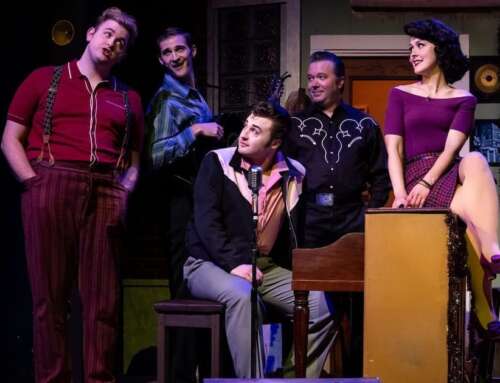Theatre Or production celebrates the relationship between SCOTUS’s first two female justices
It’s hard to imagine anyone coming away from Sisters in Law uninspired or unmoved. Written by Jonathan Shapiro (based on the book of the same title by Linda Hirshman), Sisters in Law is a story of Sandra Day O’Connor and Ruth Bader Ginsberg. Told in a series of vignetters spanning the time from 1973 to 2015, the play highlights both the commonalties and different personalities and approaches to law (and life) of the two pioneering women — the first two female justices on the U.S. Supreme Court.
If you’re not a history or legal aficionado, Sandra Day O’Connor was a moderate conservative appointed by Ronald Reagan, and Ruth Bader Ginsberg, a liberal appointed by Bill Clinton. O’Connor, played by Sally Knudsen, is portrayed as the practical westerner, building coalitions and making incremental change. Ginsberg, played by A. Lee Massaro, arrived at the court in 1993, ready to make history and passionate about advancing women’s rights. The women clash over their legal philosophies, and sometimes their methods of handling the other justices.
This is, essentially, a two-woman show. Aside from a handful of unnamed (and unspeaking) law clerks, they are alone onstage for 90 minutes, conversing through seamless and creative costume and set changes. Both women sometimes speak to their husbands, presumably just around the corner, but mostly they talk to each other and ruminate on their philosophies, legacies, and decisions. While it’s hard to pick a favorite scene, I would give a slight nod to the one in which a recovering Ginsberg in a hospital gown has an imagined conversation with a sweatsuit-clad, weight-lifting O’Connor, who reminds Ginsberg that she worked through chemo and cancer treatment herself.
O’Connor advises Ginsberg to schedule chemo for Fridays, so she’ll have time to recover and make it to court. The gravity of the situation and the humanity of the scene provide one of the most poignant moments of the play. Another is the ending, which I won’t spoil, but there was an audible wince from the audience, the members of which do not have to speculate on the outcomes of Ginsberg’s or O’Connor’s choices.
Both actresses are impressive, not only because they perform continuously but because they do such a good job portraying characters who are actual people. Likely more people will be familiar with Ginsberg’s mannerisms and ways of speaking, since she only died a year ago and had a much more public presence. The final scene addresses this phenomenon with a “Notorious RBG” poster, and a rueful O’Connor asking Ginsberg whether she sees any returns from all her merchandise.
O’Connor left the court in 2006 so she could care for her husband who had Alzheimer’s, and is still alive (though ailing herself). But while we may be less familiar with O’Connor, Sally Knudsen gives her a presence, and the audience will leave with a better understanding of who she was. I know I did. In a talk back that followed the play, a Colorado justice in the audience who had clerked for the Supreme Court and knew both justices personally noted that both actresses had nailed the mannerisms.
The production is tied to a free five-part webinar series sponsored by Theatre Or and Tattered Cover, which explores various aspects of the play and the lives of the two justices. This seems like a good opportunity to learn more and to add to the theatrical experience.
On the night I attended Sisters in Law, the audience was full of attorneys and justices, but I don’t think one needs to work in the legal field to appreciate the legacy of Ruth Bader Ginsberg and Sandra Day O’Connor, or to enjoy the talent of the actresses and all those who worked on the production. You’ll be glad you made the time to go, and if you have daughters (teenage or above) take them with you.
Blythe Smith is a widow, mom, step-mom, and writer who works for a Denver law firm. In high school she perfected her signature role - chorus person - in various school musicals.





Leave A Comment